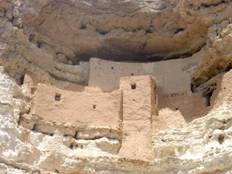|
Types of Stone Houses
By Deb Roberts

From the dawn of time, people have turned to the security, safety and comfort of stone for their houses. Naturally, miniaturists replicate stonework in our mini homes as much as we can and the results are always realistic and delightful. Let’s take a look at different types of stonework and when they were most popular.
The first known masonry homes were obviously those the cavemen chiseled out of stone. Other ancient civilizations created their homes in cliff faces that were only accessible by ladders that could be easily removed once the occupants were inside their homes. This provided a high level of security, although it does raise the question of where they put the ladder when they were away from home. This may have contributed to the creation of doors and locks, since keys are much easier to carry in one’s pocket than a ladder!
More modern uses of stone in home building have incorporated every conceivable use of rock and rock type materials from cobblestones to stucco. In regions where rock and wood are scarce, stucco and adobe literally became the building blocks of society. Stucco, a mixture of cement mud, lime and sand, has seen worldwide usage and has been documented on interior temple walls in ancient Greece and Rome, although it is primarily used as an exterior finish. Stucco was very popular during the Renaissance and Baroque periods, and again during the Arts and Crafts period. It maintains its popularity even today and can be used in almost any architectural period.
Adobe literally translates to “mud bricks” and is made of mud and straw. Adobe originated in arid regions where the soil is heavy in clay content and is still very popular in the southwest as a building material. Adobe is self-insulating and makes for a naturally climate controlled home. The building style most common with adobe features flat roof lines, rounded edges on the walls, straight edge windows, and roof beams projected thru the walls. Colors are usually earth tones in light shades.
Cobblestone houses saw a height of popularity in the mid 1800’s. Cobblestone houses can be found in any part of the world, especially in areas where rock is more prevalent than wood, or areas rich in prehistoric glacial deposits. Settlers in these areas had to remove the rocks in order to farm the land and the rocks became a ready source of inexpensive building material. Over time, masons developed more intricate designs in their buildings and cobblestone houses became true works of art.
Slate has been documented as a building material since the time of the Romans. Slate is mined in quarries and then transported to a building site. Most often, slate is used for roofing or flooring and valued for its long life span. Most popular in England, slate became more commonly used in the western world in the mid 1800’s. Slate can be laid in decorative patterns, making it quite popular with Second Empire mansard roofs and the pitched roof lines of the Victorian Gothic era. In the late 1800’s, slate was often used on both roof and exterior walls of Queen Anne style houses. The Tudor styles also used slate roofing, usually laid in a pattern of graduating size of width; larger at the eaves and smaller at the peak.
Brick can be traced back as far as 500 B.C. When it was discovered that fire-hardened brick was more durable than sun-dried adobe bricks, its popularity increased. Other advantages to brick that were more and more valued as time passed is its ability to filter sound, resulting in a quieter home. As with adobe, it is also naturally insulating, low maintenance, and withstands the elements. While it saw a decrease in popularity during the Moderne Architectural period (being eschewed as “old fashioned”) the practicality of brick was never in question and the Moderne architects covered their brick buildings with plaster or concrete to give it a neutral and high tech look. However, brick can be found in almost every era of architecture and utilized in every method from complete load bearing structures, to facades, to the infill used in Tudor styles.
As miniaturists, we build our creations from wood, but adding stone finishes is easy to do with products such as Greenleaf Stucco, Paperclay, Magic Masonry systems, or just plain old rocks! Don’t be afraid to experiment with stone finishes and you’ll be delighted at the results!
Back to the July Newsletter... |